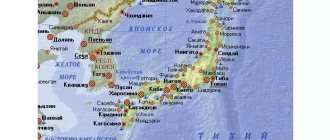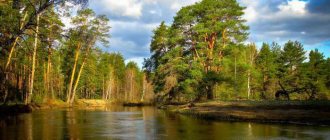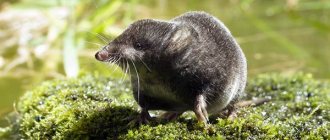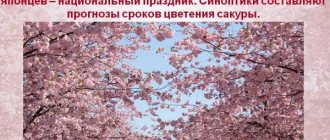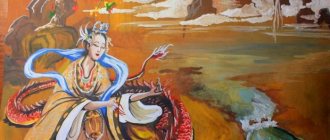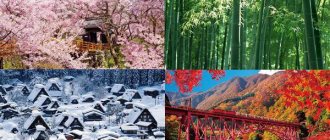The country of Japan is amazing and inexplicable. The nature of Japan was formed according to the island principle and bears little resemblance to neighboring countries. The Japanese have long understood that no benefit of civilization can replace a corner of wildlife. Therefore, they are trying their best to preserve the flora and fauna of their islands. And in order to better understand the unique nature of the country, you need to understand its geographical location.
Land of the Rising Sun
The Japanese themselves call their country “Nippon” or “Nihon Koku”. This name can be translated as “the land where the sun rises.” The country is located in East Asia and occupies more than 6,800 large and small islands. Although only 4 of them can be considered large: Honshu, Hokkaido, Kyushu, Shikkoku.
The islands are called the Japanese archipelago. Most of them are mountainous or volcanic formations. The highest point of the country is on the island of Honshu. This is the famous Fuji volcano, whose height is 3776 m. The wildlife of Japan was confined to the islands and developed depending on the climatic zones.
Babies with old people's faces
Fuji makes the island of Honshu stand out from the entire Japanese archipelago. Therefore, here are the most attractive places for excursions. In the vicinity of Nagano, for example, tourists are very interested in the high-altitude Jigokudani Park. It has the harshest climate for the country and snow lasts longer in winter. But from the crevices of the stones, hot water vapor rises everywhere.
READ ALSO: Brazil - its nature
In the fog, on the rocks you can see flocks of sitting macaques, which have long chosen these places. Snow monkeys, as the Japanese call them, have adapted well to life in hot springs. They are busy with their own worries and pay almost no attention to park visitors.
But it’s very funny to watch the bustle of these cute primates. True, when intrusively approaching their territory, animals can be unpredictable. It’s easy to miss the moment when a nimble animal snatches your phone and gallops off to show it to its fellows.
Snow monkeys love to swim in the warm waters of the springs. Having thick fur, they are not afraid to get it wet; they dive and splash, snorting funny. In the cold, macaques doze in the lakes, immersed up to their necks in water and huddled together. They look simply hilarious.
Climate zones
The country's territory is conventionally divided into 6 climatic zones:
- Low temperature zone with frosts in winter and average summer. This zone includes the large island of Hokkaido.
- Zone of northeast winds (seasonally) with winter snowfalls and cold summers. The Sea of Japan lies in this zone.
- An island climate zone with slight temperature fluctuations. This is where the Central Highlands are located.
- A temperate climate zone in which two mountains (Chugoku and Shikoku) stop the seasonal winds. This includes the Inland Sea of Japan.
- The Pacific zone with cold winters with little snow and hot rainy summers.
- A subtropical climate zone with warm winters and hot summers. Here the level of precipitation is so high that there is a rainy season and typhoons occur. The Southwestern Islands lie in this zone.
Now you understand how different island Japan looks. The nature of Japan takes on new features from island to island. Traveling around the country, you always get to know something new.
What was behind the decree of compassion for living beings?
Tsunayoshi, the fifth Tokugawa shogun, issued the famous decree “On the Prohibition of Taking the Life of Living Creatures” in 1687, which prohibited the killing of any animals and the consumption of meat. In fact, this is not one document, but a general name for acts about which the population was notified 135 times - presumably because it was often violated. The category of “living beings” included dogs, cats, birds, fish, and even shellfish and insects. Most often, 40 times, they called for not killing birds, followed by cats and dogs (33 times) and horses (17 times).
Historical series tend to portray this as brutal laws that led to tens of thousands of people being arrested. However, Tokugawa Tsunenari, a descendant of the Tokugawa shogun family, in his book “Genes of Edo” (Edo no idenshi, “PHP kenkyujo”) writes in defense of his ancestor: “Over the 24 years of publication of these acts, 69 people were punished, and only 13 people."
In fact, Tsunayoshi's decrees clearly demonstrate the ethical principle of protecting the weak - orphans, old people, the sick, the exhausted. There were decrees that established the death penalty for the owner of an inn who took things from exhausted travelers, or for one who threw a foundling into the river.
Foundlings were not supposed to be given to the authorities, but to be raised by oneself or given to those who wanted to adopt an adopted child. To prevent child abandonment, it was ordered to keep household lists of children. For exhausted people there were institutions where the poor were provided with material assistance.
Tsunayoshi's decrees on dogs, prohibiting, for example, driving them out, attract attention - because of them he received the nickname “dog shogun” (inu kubo). At that time there were many stray dogs, and they often attacked people
In order not to increase their number, it was ordered to create a system for registering dogs, in which dog hair was attached to the document. In England, the animal welfare law was passed in 1911, so Japanese legislation is the oldest in this area.
In Edo, dog care facilities were established in Okubo, Yotsuya and Nakano. Located in Nakano, the Okakoi Goyo Yashiki (Fenced Estate) occupied an area of 100 hectares (about 20 Tokyo Dome stadiums). At its busiest, it housed more than 80,000 dogs. In memory of this institution, bronze figures of five dogs were installed next to the Nakano City Administration building.
Best articles: Which birds fly south in winter: names, photos and brief descriptions of migratory bird species
Sculptures of dogs near the Nakano City Hall (PIXTA)
In recent years, the role of Tokugawa Tsunayoshi has been re-evaluated; if earlier he was perceived as a bad ruler, now he is often spoken of as an outstanding shogun. The German doctor Engelbert Kaempfler, who twice had an audience with the shogun, writes in his “Diary of a Travel to Edo” that Tsunayoshi made a strong impression on him as an excellent ruler.
Flora
Almost 67% of the country's territory is covered with forests. Many endemic plants are found here. Photos of Japanese nature introduce unique species that are found in limited areas. We'll talk about endemic plants below. And here we give a description of the flora of the country as a whole.
Forest areas vary depending on climatic zones. Thus, coniferous spruce and fir forests are green in Hokkaido. The undergrowth here is overgrown with bamboo. As you gain height, the amount of dwarf cedar increases, and herbaceous and shrub formations appear. The coniferous forests of the southern part of the island rise up to 500 m above sea level. And the southern part of the island is covered with thickets of deciduous forests, which end at the same height.
Another large island, Honshu, is covered with deciduous forests. Here you can find familiar oaks and beeches. Maples and chestnut trees grow, ash and linden are available. The upper limit of deciduous forests runs at 1800 m. Coniferous thickets rise to 2000 m.
The islands of Shikoku and Kyushu are rich in subtropical forests. Evergreen oak, beautiful magnolia, camphor tree, and cryptomeria predominate here. Many species of vines grow abundantly in the undergrowth.
Natural features of Japan (region of the Ryukyu Islands) are dense monsoon forests. Palm trees and ficus trees are a common sight in these places. Tree ferns, many types of orchids and bamboo also grow here.
Content Features
The Japanese are limited by a number of rules in any area and keeping pets is no exception. Especially, these rules apply to those who live not in private houses, but in corporate shared apartment buildings.
- Pet owners can be tracked down and fined for making noise and disturbing the rest and sleep of their neighbors.
- The owner bears full responsibility for the animals
- Due to limited space, animals, especially dogs, should be walked in special sectors where they can run and frolic with their own kind.
- Even if you buy your own apartment, it is not a fact that you can afford a pet.
The Japanese love animals very much, since they agree to go through the registration process and then follow strict maintenance standards. Indeed, for the sake of such cute furry happiness, you can be patient. This is where I end the article, subscribe to updates and recommend my blog to your friends. See you later!
In Japan, as in the vast majority of other countries, they love pets. But not everyone can afford their own pet. This is due to the presence of certain requirements enshrined at the legislative level.
For example, a resident of an average city apartment, by definition, cannot get a large dog. It is believed that there is too little space in the apartment for such animals and therefore the Japanese prefer dachshunds, retrievers and Akita dogs.
The most popular pet is the cat. It all started back in the fourth century, when cats were brought to the Land of the Rising Sun. Then they lived exclusively in the Imperial Palace, and a random person was lucky to see one of these furry animals in person.
Over time, cats began to appear first among members of the nobility, and then in ordinary homes. They immediately became a symbol of well-being and comfort. As a result, there are now several million cats living in Japan, and their number continues to increase.
Examples of plants endemic to Japan. Cryptomeria japonica
So what wonders can Japan surprise? The nature of Japan has preserved, for example, the unique plant Cryptomeria japonica. Scientists once mistakenly attributed this plant to cedars, but then realized that it was a representative of the cypress family.
The tree can grow up to 50 m. It has a dense crown and subulate-shaped leaves, slightly curved at the base. The seeds ripen in spherical cones. The plant is found on several islands in Japan and in a limited area in China.
Japanese spider crab
photo
The Japanese spider crab is often called the most feared of all animals in Japan. This is one of the largest representatives of arthropods in the world. Its spread legs can span over 3.5 meters. The good news is that the Japanese spider crab lives on the seabed at depths of fifty to three hundred meters, so you probably won't encounter one on the beach or while swimming in the sea. But you can look at this giant at the Kaiyukan Aquarium, Osaka.
If you find an error, please select a piece of text and press Ctrl+Enter
.
A dog in Japan, as throughout the world, is a faithful and devoted friend. Since the times of the samurai, loyalty and devotion have been considered one of the most important criteria of human life. On the other hand, “dog” is one of the worst curse words in Japan. That is, if a person is called a “dog”, it is humiliating. But they still love dogs.
If in villages and on the periphery dogs live completely calmly in the houses of their owners, go out for walks, and everything is fine with them, then in big cities (Tokyo, Osaka and other million-plus cities) a dog, by the very fact of its existence, commits the most terrible sin that the Japanese only can imagine - begins to cause inconvenience to others.
The dog can go to the toilet outside, bark, and run around the house. Therefore, now there are a huge number of deterrents and restrictions on keeping a dog. You need to read the rules of the apartment you rent or buy very carefully. In new houses, a rule has already begun to appear, according to which you initially cannot keep pets there: neither dogs nor cats, as this will disturb the peace of others. But in private homes, where such rules do not apply, many Japanese live with dogs.
Best articles: Which ocean is the northernmost on Earth?
Moreover, simply adopting a dog from the street is no longer an option. Many people are ready to pay absolutely terrible money to buy a puppy with an elite pedigree. They are sold in pet stores, which are thriving throughout the country.
They don't have anything.
There are just too many strollers here.
There is absolutely something for every taste and every breed.
Here is a sophisticated option for aristocratic breeds.
But brutal is for serious people.
There are even sleds for dogs! Not to be confused with a dog sled: in Japan, man and dog switched places. Now Homo sapiens is a mount.
Clothes and accessories. You can dress in the same style as your dog.
It's like in the children's clothing department.
In one store in Tokyo, even Lady Gaga bought herself a puppy for incredible money.
If you are buying a puppy, you need to make sure that it does not disturb anyone. When you walk him, you take a portable dog litter box with you. Once your dog marks territory, you must clean up after it. You can’t just throw dog poop somewhere in the city - you take it home with you and throw it away at home.
If you are walking with a pet in crowded areas, the Japanese consider it a rule of good manners to have a dog stroller.
A stroller is not a whim, but a necessity for walking with your pet along the central streets.
If you walk with a dog on a leash, the Japanese will look at you askance. And if she allows herself to lick someone’s foot, the person can easily call the police: “What kind of rules do you have, why did the dog lick my shoe?”
For dogs in Japan there are hotels, hairdressers, and supermarkets with a huge selection of dog food.
This business is booming here.
Dogs want to look irresistible!
It’s the same with cats: if you keep a cat, you should definitely trim its claws so that it doesn’t scratch and the neighbors can’t complain about a strange noise.
Cats are also often walked in strollers.
But there are significantly more dogs as pets in Japan than cats.
This is such forced fanaticism! Can you imagine all this here?
By the way, don't forget to watch my latest Japanese videos:
It might be useful to read:
- Business plan for opening a tobacco kiosk;
- A simple homemade utilitarian frame for special glasses;
- How to make a lorgnette from ordinary glasses;
- Good Night Wishes;
- Magnetic resonance imaging of the temporal bones How does a blood clot occur?
- Blood supply to the small intestine;
- What does secretory immunoglobulin a show?
- Common diphtheria;
Fauna of Japan
The fauna of the Japanese archipelago is poorer than that of the mainland. But it is also rich in endemic and relict species. Japan (nature of Japan) has preserved 270 species of mammals. It is represented by eight hundred species of birds and more than one hundred species of reptiles. The seas are home to numerous shellfish and fish. Animals that have inhabited land are adapted to living in mountain forests.
The fauna of Hokkaido includes brown bears, sables, stoats and weasels. The brown bear is considered one of the largest predators in Japan. Here you can also find wolves, foxes, raccoon dogs, Asian badgers and squirrels.
A similar fauna is characteristic of the island of Honshu. But there are no large brown bears or fur-bearing sable here. But there is a unique endemic - the giant salamander. The length of this amphibian is almost 1.5 m. Gigantic salamanders are also found in small numbers on the islands of Kyushu and Shikoku. It is worth noting that this is the largest amphibian on Earth. Japanese snow macaques also live on Honshu.
The island of Tsushima is home to the endemic Bengal cat and the endemic Japanese sable. In addition, badgers and stoats are common.
Representatives of the fauna of Japan include dormouse, flying foxes, sika deer and Japanese serow, flying squirrels and hares. Moreover, several species of hares are endemic (Japanese and climbing). The climbing hare generally lives only on two small islands - Amamioshima and Tokunoshima.
Watching the flights of numerous birds, you especially understand how beautiful the nature of Japan is. The endangered Japanese crane, which is the largest bird in the crane family, is found here. Among the common predators in Japan are Steller's sea eagles, golden eagles, goshawks, snake eagle, eagle owls and owls. Geese, ducks, swans and storks are represented in large numbers. Many sea and forest birds.
There are many turtles, lizards and snakes on the islands of Japan. Of great interest are the softshell and loggerhead turtles.
Departure airport
First of all, don't be late. It's corny, of course, but I had to say it.
Add at least 1 hour to the check-in time at the airport. And better - more. And come early. It will be very disappointing if, after all the torment described above, you do not have time to register the animal or even yourself. And yes, just in case, it will be better if someone accompanies you - this will increase your mobility, and in case of unforeseen circumstances, you will be able to quickly resolve any issue (you never know, they won’t accept the animal - anything can happen).
Having arrived at the airport, go to the PKVP along with the animal and all documents related to it. There, your form No. 1 will be exchanged for a certificate of form No. 5A.
After receiving the certificate, go to check-in and baggage drop-off. I repeat - usually animals are required to be placed in special cages. I myself transported a cat in exactly this way, so I am describing exactly my case.
Upon registration, you will be asked to pay for the transportation of the animal (oversized luggage) and the cage will be sealed and accepted for loading. Having received the cage back in Japan, you do not have the right to open it without permission from the quarantine service staff.
Best articles: Guard dogs: varieties and features
National natural parks
For many years, Japan's unique and beautiful nature has suffered greatly from human activity. Forests were actively being pushed aside by agricultural land, putting many plants and animals on the brink of survival. The year 1950 was a turning point for environmentalists. The country's government passed a law that gave a large number of plants the status of national natural monuments. The list includes more than 400 species.
Considering that the list of endemic plants and animals in Wikipedia alone contains 118 items, it is not surprising that a large number of national parks are being created in the country. In 2007, their number reached 30, and the very first parks were created in 1934. The Japanese are trying to preserve the natural ecosystem of their territory. They have long understood that 5 minutes of contemplation of nature heals the soul better than any doctor.
Garden of bold shoots
For those who came to the country for the first time, it’s time to go to the main Japanese grove. This is a man-made bamboo forest in Sagano, southwest of Lake Biwa, in Kyoto Province. Don't be alarmed, you won't have to wade through a thicket of hard trunks. The forest has extremely beautiful and well-groomed paths and alleys.
The monk who founded this marvelous forest lived in the Middle Ages. He was an enlightened poet and wished to embody his inspiration in arranging the temple complex with sacred plantings. Grateful descendants maintain the bequeathed idyll here, showing care and diligence in caring for the park.
Slender bamboo thickets are not at all like the usual forest. You can imagine yourself here as an ant among the huge blades of meadow grass. Or come up with a magical dream for yourself to remember later at night. The Japanese themselves believe that a slender beauty sleeps in every tall bamboo trunk. When she wakes up, she will part the fibers and appear to her lover.
And the grove emits a melodious, drawn-out melody. This voice of bamboo is like an arrangement for the truly Japanese flavor of calm, courage and restrained happiness.
